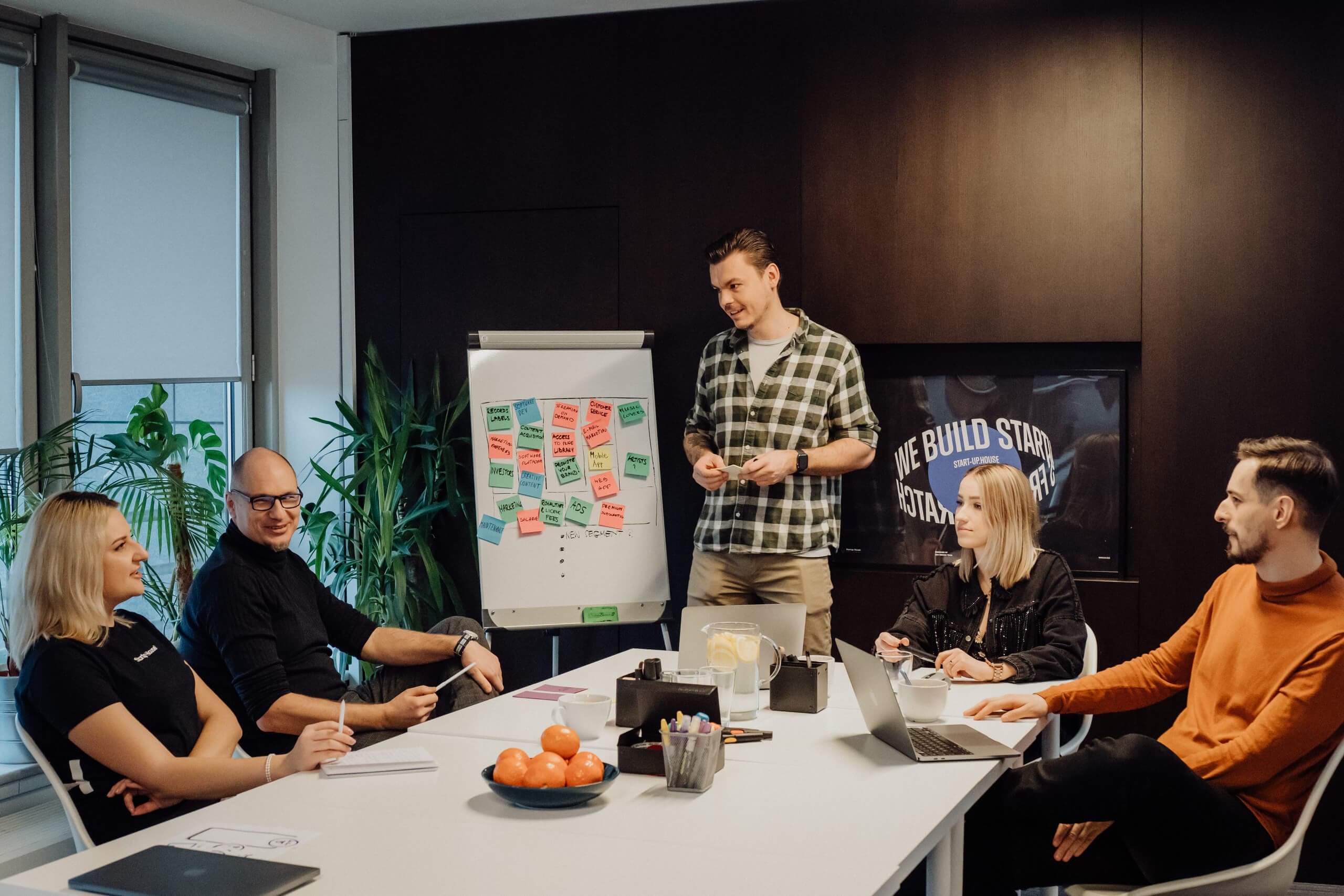Mastering Agile: A Practical Guide to Implementing Agile Methodology
Alexander Stasiak
Oct 02, 2024・5 min read
Table of Content
Understanding Agile Methodology
Origins of Agile
Core Principles of Agile
Benefits of Agile Implementation
Preparing for Agile Adoption
Assessing Organisational Readiness
Building an Agile Team
Creating a Supportive Culture
Implementing Agile Practices
Setting Up Agile Frameworks
Developing Agile Workflows
Measuring Agile Success
Overcoming Common Challenges
Navigating Resistance to Change
Managing Agile Misconceptions
Sustaining Agile Momentum
Continuous Improvement in Agile
Embracing Iterative Processes
Encouraging Team Collaboration
Leveraging Feedback for Growth
Mastering Agile methodology has become essential for teams striving to enhance productivity and adaptability. Agile, with its emphasis on iterative development and collaboration, offers a flexible approach to project management that can drive remarkable results. This guide aims to provide a clear, practical roadmap for the implementation of Agile methodology, equipping you with the knowledge to seamlessly integrate its principles into your workflow. By following the steps outlined, you will be well on your way to achieving a more efficient and responsive organisational structure.
Understanding Agile Methodology
Origins of Agile
The Agile methodology finds its roots in the 1990s when software developers sought alternatives to traditional, rigid project management practices. The need for a more flexible approach emerged as projects became increasingly complex and fast-paced. Agile's inception was marked by the creation of the Agile Manifesto in 2001 by a group of seventeen software developers. This manifesto outlined the core values and principles that prioritise customer collaboration, working software, and adaptability over cumbersome documentation and inflexible plans. Agile's philosophy centres on iterative development, encouraging teams to break down projects into manageable parts to allow for regular reassessment and adjustment. This approach fosters a culture of continuous improvement, enabling organisations to respond promptly to change and better meet client needs. By understanding Agile's origins, you can appreciate the methodology's emphasis on flexibility and collaboration, which are integral to its successful implementation in various industries.
Core Principles of Agile
Agile methodology is built on a framework of core principles designed to enhance team effectiveness and project outcomes. At its heart, Agile prioritises individuals and interactions over processes and tools. This means fostering a collaborative environment where team members communicate openly and work together. Another principle is delivering working software frequently, with a preference for shorter timescales. This ensures that teams can adapt to changes quickly and deliver value incrementally. Customer collaboration is also key, involving stakeholders throughout the development process to ensure the final product meets their needs. Agile champions responding to change over following a set plan, allowing teams to pivot and adjust as necessary. Additionally, Agile encourages sustainable development, meaning that teams should work at a pace they can maintain indefinitely. By adhering to these principles, teams can create a flexible, responsive workflow that can lead to more successful project implementations.
Benefits of Agile Implementation
Implementing Agile methodology offers numerous benefits that can greatly enhance an organisation's efficiency and effectiveness. One of the most significant advantages is increased adaptability. Agile allows teams to respond swiftly to changes in project requirements or market conditions, ensuring that deliverables are always aligned with current needs. This flexibility often leads to improved product quality, as continuous testing and feedback loops help identify and rectify issues promptly. Agile also fosters enhanced collaboration and communication within teams, breaking down silos and encouraging a culture of shared responsibility. This can lead to higher team morale and job satisfaction, as individuals feel more engaged and valued. Additionally, Agile's iterative approach promotes early and frequent delivery of value, which can boost customer satisfaction and loyalty. By embracing Agile, organisations can benefit from a more streamlined workflow, delivering projects more efficiently and effectively. This makes Agile an invaluable tool in today's fast-paced business environment.
Preparing for Agile Adoption
Assessing Organisational Readiness
Before diving into the implementation of Agile methodology, it's crucial to assess your organisation's readiness for such a transformation. Start by evaluating the current organisational culture. Agile thrives in environments that value collaboration, open communication, and flexibility. Consider whether your team is accustomed to working in cross-functional units and if there is a willingness to embrace iterative processes. Leadership support is another vital factor; leaders should be committed to the Agile journey and prepared to drive change from the top. Review existing processes and tools to identify any potential barriers to Agile practices. It's also beneficial to assess the readiness of your IT infrastructure, as Agile often requires tools that support continuous integration and delivery. Training needs should not be overlooked; ensure that team members have access to the resources and education necessary to understand and apply Agile principles effectively. By thoroughly assessing these aspects, you can lay a strong foundation for a successful Agile adoption.
Building an Agile Team
Creating an effective Agile team is a cornerstone of successful Agile adoption. Start by assembling a diverse group of individuals who bring a range of skills and perspectives to the table. An Agile team typically includes roles such as product owner, scrum master, and developers, each contributing to the project's success. The product owner represents the stakeholder's interests and prioritises the backlog. The scrum master facilitates Agile processes and removes obstacles that might hinder the team's progress. Developers, testers, and designers collaborate to deliver iterations of the product. It's essential to foster a culture of trust and mutual respect within the team, as Agile relies heavily on open communication and collaboration. Encourage team members to take ownership of their work and contribute to decision-making processes. Providing opportunities for continuous learning and development will also help in maintaining high levels of motivation and engagement. By building a strong Agile team, you set the stage for a smooth and effective Agile implementation.
Creating a Supportive Culture
Establishing a supportive culture is crucial for the successful implementation of Agile methodology. This begins with leadership fostering an environment that embraces change and encourages experimentation. Leaders should actively support Agile principles, demonstrating commitment by providing the resources necessary for teams to thrive. Open communication must be a priority, enabling team members to freely share ideas, feedback, and concerns. Recognising and celebrating successes, as well as learning from failures, is vital to maintaining motivation and encouraging continuous improvement. A supportive culture also values collaboration over competition, promoting teamwork across departments and levels. Empowering employees by involving them in decision-making processes can enhance their sense of ownership and accountability. Training and development opportunities should be made available to equip team members with the skills needed to adapt to Agile practices confidently. By nurturing a culture that supports Agile values, organisations can create an environment where innovation and efficiency flourish.
Implementing Agile Practices
Setting Up Agile Frameworks
When implementing Agile practices, choosing the right framework is a pivotal step. Popular Agile frameworks include Scrum, Kanban, and Extreme Programming (XP), each offering unique approaches suitable for different project needs. Scrum, for instance, is ideal for projects requiring regular feedback and flexibility, with its cycles of sprints and daily stand-up meetings. Kanban focuses on visualising workflow and limiting work in progress to improve efficiency, making it well-suited for teams looking to optimise continuous delivery. Extreme Programming emphasises technical excellence and frequent releases, which is beneficial for teams prioritising software quality. Once you've selected a framework, define roles and responsibilities clearly within your team to ensure smooth operation. Establish processes for regular review and adaptation to keep the framework aligned with project goals. Providing tools and resources that facilitate Agile practices, such as project management software, can further support the framework's implementation. With a well-chosen framework, your Agile practices can lead to improved productivity and outcomes.
Developing Agile Workflows
Creating effective Agile workflows is essential for streamlining processes and enhancing team productivity. Start by breaking down projects into smaller, manageable tasks, allowing for regular progress assessments and adjustments. This iterative approach enables teams to focus on delivering value incrementally, making it easier to adapt to changes and feedback. Incorporate regular planning sessions, such as sprint planning or backlog refinement, to prioritise tasks and align team efforts with project goals. Daily stand-up meetings can help maintain transparency and communication among team members, ensuring everyone is on the same page. It's also important to establish a system for tracking progress, such as using visual tools like Kanban boards or burndown charts. These tools can help teams monitor work in progress and identify bottlenecks. Encourage a culture of continuous feedback and improvement, allowing workflows to evolve as the team learns from each iteration. By developing Agile workflows, teams can achieve greater efficiency and adaptability.
Measuring Agile Success
To gauge the effectiveness of Agile implementation, it's crucial to establish clear metrics for success. Start by defining key performance indicators (KPIs) that align with your organisational goals. Common Agile metrics include velocity, lead time, and cycle time, which provide insights into team productivity and efficiency. Velocity measures the amount of work completed in a sprint, helping teams forecast future performance. Lead time tracks the duration from task creation to completion, while cycle time focuses specifically on the period during which work is actively in progress. Additionally, consider qualitative measures such as team morale and customer satisfaction, which can be assessed through surveys and feedback. Regularly review these metrics in retrospectives to identify areas for improvement and celebrate successes. It’s essential to maintain a balance between quantitative and qualitative assessments to gain a holistic view of Agile performance. By measuring Agile success thoughtfully, organisations can continuously refine their practices for optimal results.
Overcoming Common Challenges
Navigating Resistance to Change
Resistance to change is a common hurdle when implementing Agile methodology, often stemming from uncertainty and discomfort with new processes. To effectively navigate this resistance, communication is key. Clearly articulate the benefits of Agile, addressing how it can enhance productivity, flexibility, and job satisfaction. Involve team members in the transition process, encouraging them to voice concerns and contribute ideas. Providing training and resources can also help alleviate apprehension by boosting confidence in new skills and practices. Establish change champions within the organisation—individuals who can advocate for Agile and demonstrate its value through their actions and results. Additionally, celebrate small wins and milestones to highlight progress and build momentum. By fostering an open and supportive environment, you can gradually shift mindsets and reduce resistance. Remember, successful change management involves patience and persistence, ensuring that everyone feels included and valued throughout the transformation journey.
Managing Agile Misconceptions
Managing misconceptions about Agile is essential for its successful implementation. One common misunderstanding is that Agile lacks structure and planning, when in fact, it involves meticulous planning and continuous evaluation. Educate teams on Agile's structured approach to iterative development and its emphasis on regular feedback and adaptation. Another misconception is that Agile is only applicable to software development; however, its principles can be adapted to various industries and project types. Address these misconceptions by providing workshops and training sessions that demonstrate Agile's versatility and effectiveness. Additionally, some may assume Agile guarantees faster delivery without compromising quality. Clarify that while Agile can lead to more efficient processes, the focus is on delivering value and quality incrementally. Regularly communicate these clarifications through meetings and documentation to ensure alignment across the organisation. By addressing these misconceptions, you pave the way for a more informed and supportive environment conducive to Agile success.
Sustaining Agile Momentum
Maintaining momentum in Agile practices is crucial for long-term success and requires ongoing commitment and adaptability. Begin by ensuring continuous engagement from leadership, as their support is vital in driving Agile initiatives. Encourage regular feedback cycles within teams to foster a culture of continuous improvement. Retrospectives can be particularly effective, providing opportunities to reflect on past work and make adjustments where necessary. Keeping training and development opportunities readily available helps teams stay updated on best practices and emerging trends in Agile. Additionally, celebrating achievements and recognising team efforts can boost morale and reinforce Agile values. It's important to monitor Agile metrics consistently to track progress and identify any areas for enhancement. Be open to evolving processes and tools as the organisation and market conditions change. By focusing on these strategies, you can sustain Agile momentum, ensuring that your team remains agile and effective in the face of future challenges.
Continuous Improvement in Agile
Embracing Iterative Processes
Embracing iterative processes is a cornerstone of Agile methodology, facilitating continuous improvement and adaptation. This approach involves breaking down projects into smaller, manageable iterations or cycles, allowing teams to focus on delivering incremental value. Each iteration typically involves planning, development, testing, and review phases, enabling teams to refine and enhance the product progressively. By working in iterations, teams can respond swiftly to feedback and changing requirements, ensuring the final product meets stakeholder expectations. Iterative processes also help in identifying and addressing issues early, reducing the risk of costly rework. Encouraging a mindset of experimentation and learning within the team is vital, as it promotes openness to change and innovation. Regularly reviewing and reflecting on completed iterations through retrospectives can lead to valuable insights and improvements. By fully embracing iterative processes, organisations can achieve greater flexibility, efficiency, and quality in their project outcomes, maintaining a competitive edge in the market.
Encouraging Team Collaboration
Fostering team collaboration is essential for continuous improvement in Agile environments. Collaboration enables diverse team members to contribute varied perspectives and expertise, leading to more innovative solutions and streamlined processes. To encourage collaboration, create a culture that values open communication and mutual respect. Regular meetings, such as daily stand-ups and sprint reviews, provide platforms for team members to discuss progress, share ideas, and address challenges together. Utilise collaboration tools and platforms that facilitate seamless communication and information sharing, both for co-located and remote teams. Encourage cross-functional teamwork, allowing individuals from different disciplines to work closely and learn from one another. Recognise and reward collaborative efforts to reinforce the importance of teamwork. Providing team-building activities and opportunities for social interaction can also strengthen relationships and trust among team members. By prioritising collaboration, teams can enhance their collective problem-solving abilities and drive continuous improvement in Agile practices.
Leveraging Feedback for Growth
In Agile environments, leveraging feedback is crucial for fostering growth and continuous improvement. Feedback serves as a tool for refining processes, enhancing product quality, and addressing team dynamics. Start by establishing regular feedback loops, such as sprint reviews and retrospectives, where team members can share insights and suggestions openly. Encourage a culture of constructive feedback, where criticism is viewed as an opportunity for improvement rather than a personal attack. Actively involve stakeholders and customers in the feedback process to ensure the product aligns with their needs and expectations. Use feedback data to make informed decisions on prioritising tasks and adjusting workflows. Implementing feedback mechanisms also helps in identifying skill gaps and training needs, facilitating professional development. By valuing and acting on feedback, teams can adapt more effectively to change, innovate continuously, and maintain a trajectory of growth and improvement within Agile frameworks. This approach ultimately contributes to delivering higher value to customers and stakeholders.
Digital Transformation Strategy for Siemens Finance
Cloud-based platform for Siemens Financial Services in Poland


You may also like...

Mastering Declarative Programming: Essential Practices for Every Developer
Discover declarative programming essentials. This guide covers principles, tools, and best practices to simplify coding, enhance readability, and improve scalability.
Marek Pałys
Apr 16, 2024・11 min read

Understanding Event-Driven Programming: A Simple Guide for Everyone
Explore the essentials of event-driven programming. Learn how this responsive paradigm powers interactive applications with real-world examples and key concepts.
Marek Pałys
Apr 30, 2024・9 min read

Demystifying Procedural Programming: Simple Examples for All
Explore procedural programming with easy-to-follow examples and insights into its core principles. Learn how this step-by-step approach forms the basis of many programming paradigms.
Marek Pałys
Jul 05, 2024・10 min read




